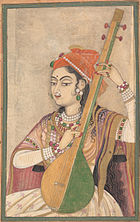나크노
NacnīNacni는 북인도어로 여성 무용수를 의미한다. 인도 동중부 자르칸드, 웨스트벵갈, 오리사 주에서 nacnī(빛. "댄서" 발음 NUCH-nee)라는 용어는 농촌 지역에서 전문적으로 노래하고 춤추는 여성 연주자를 말하며, 그와 함께 무대를 돌아다니는 남성 ḍ훌k과 나가라 드러머를 동반한다.[1][2]
nacnows로 공연하는 여성은 "kickt women"으로 간주되며, 일반적으로 남성 매니저 및 댄스 파트너와 비공식적인 "결혼"으로 짝지어지는데, 이는 전형적으로 더 높은 카스트의 것이다.[3][4] 이 페어링에서 nacnīs는 Radha 여신을 형상화한 것으로 생각되는 반면, 남성 춤 파트너는 크리슈나의 스탠드인 것이다. 공연자들은 왕따를 벗어난 것으로 간주되며, 많은 면에서 무대 위와 오프 모두에서 일반적인 인도 카스트와 성별 구분을 위반하며, 그들의 "팬"들 사이에서 특정한 권력적 역할을 맡고 종종 음주와 흡연과 같은 "일반적으로 남성" 행동을 한다.[5][6] 이런 공연 스타일은 빠르게 사라지고 있다.[7]
참조
- ^ Babiracki, Carol M. (2008), "Between Life History and Performance: Sundari Devi and the Art of Allusion", Ethnomusicology, 52:1: 1–5
- ^ Citron, Marcia J. (2005), "Women's Voices across Musical Worlds (review)", Music and Letters, 86: 508–512, doi:10.1093/ml/gci090
- ^ Feldman & Gordon (2006). The courtesan's arts: cross-cultural perspectives. New York: Oxford University Press. p. 118. ISBN 9780195170290.
- ^ Babiracki, Carol M. (2008), "Between Life History and Performance: Sundari Devi and the Art of Allusion", Ethnomusicology, 52:1: 3–6
- ^ Soren, Ragnhild (1999), Gendered Images of Music and Musicians (PDF)
- ^ Babiracki, Carol M. (2008), "Between Life History and Performance: Sundari Devi and the Art of Allusion", Ethnomusicology, 52:1: 5–6
- ^ Feliciano, Rita (2006), "Kathak at the Crossroads: Innovation Within Tradition", Dance View Times, 4:35


